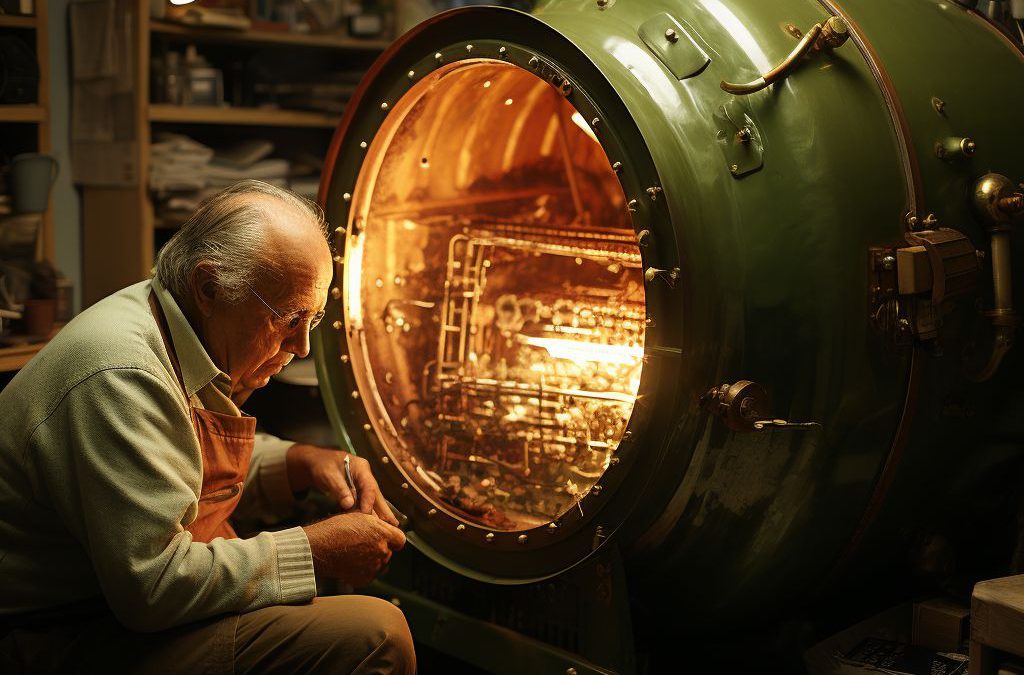Frigid winter mornings demand warm and cozy interiors, and a gas boiler is undoubtedly one of the most convenient appliances to keep your home toasty. Gas boilers are energy-efficient and emit fewer pollutants compared to other heating systems. Although turning on a gas boiler may seem like an easy task, it can be dangerous if done incorrectly. In this article, we will guide you through a step-by-step process to turn on a gas boiler safely and efficiently. So, let’s get started!
Tabe of Contents
1. Understanding Gas Boilers: A Beginner’s Guide
Gas boilers are a type of heating system that use gas as their primary fuel source. They work by burning gas fuel to heat water, which is then circulated through pipes throughout a home or building to provide warmth. Understanding how a gas boiler works is essential for ensuring proper usage and maintenance.
Gas boilers are made up of several main components including a burner, heat exchanger, flue system, and controls. The burner is responsible for igniting the gas fuel and creating a flame, while the heat exchanger is responsible for transferring the heat from the flame to the water. The flue system allows for the safe removal of combustion gases, while the controls regulate the overall operation of the boiler.
It is important to note that gas boilers should only be installed and maintained by qualified professionals. Attempting to work on or repair a gas boiler without proper training and certification can be extremely dangerous.
By understanding the basic components and functionality of a gas boiler, you can ensure safe and efficient operation for years to come.
2. Precautions To Take Before Turning On Your Gas Boiler
Before you turn on your gas boiler, there are a few safety precautions that need to be taken to ensure your safety and the safety of those around you.
1. Check for leaks
One of the most important things to do before turning on your gas boiler is to check for any signs of leaks. This can include smelling gas in the air, hissing sounds coming from the pipes, or bubbles appearing on the surface of the water in the boiler. If you detect any of these signs, turn off the gas supply immediately and call a licensed technician to come and fix the problem.
2. Ventilation
Gas boilers require proper ventilation to avoid any build-up of harmful gases like carbon monoxide. Before turning on your boiler, make sure that there is adequate ventilation in the room, and that all air vents are clean and free from any obstructions. A lack of proper ventilation could lead to serious health problems, so it’s important to ensure that this step is completed before turning on your boiler.
3. Read the manual
Every gas boiler is different, and it’s important to read the manufacturer’s instructions before turning on your specific boiler. The manual will provide you with information regarding the correct way to turn on your boiler, how to diagnose problems, and what to do in the case of an emergency. Make sure to keep the manual handy for quick reference.
By following these simple precautions, you can ensure a safe and efficient use of your gas boiler. Remember, safety should always come first, so take the time to prepare before turning on your boiler.
3. Step-by-Step Guide To Turning On a Gas Boiler
If you are new to using a gas boiler, you might be wondering how to turn it on. Fortunately, it’s a straightforward process, and we’ve broken it down into easy-to-follow steps.
Step 1: Check The Gas Source – Before turning on your gas boiler, ensure that the gas supply is turned on. You should see a valve on the gas pipe that leads to the boiler. Make sure it is in an open position.
Step 2: Turn On The Boiler – The next step is to turn on the boiler itself. Locate the power switch or button that activates the boiler and turn it on. You should hear the boiler start to initiate, and the ignition process should begin.
Step 3: Check The Pilot Light – Once the boiler is turned on, check the pilot light. This is a small flame that should be visible through a small window on the front of the boiler. If the pilot light is not lit, follow the manufacturer’s instructions for lighting it.
Step 4: Adjust The Thermostat – After the pilot light is lit, adjust the thermostat to the desired temperature. Your boiler should begin heating the water in the tank and distributing it to your home’s radiators or underfloor heating system.
Step 5: Monitor The System – Finally, monitor your gas boiler system to ensure that it is functioning correctly. Listen for any unusual noises, and check that the radiators or underfloor heating system are heating up. If you notice anything out of the ordinary, turn off the boiler immediately and seek professional assistance.
By following these simple steps, you can turn on your gas boiler confidently and ensure that it is functioning correctly. Remember to always take care when dealing with gas, and if you are unsure about any aspect of your gas boiler system, seek professional advice.
4. Tips To Ensure Smooth Functioning Of Your Gas Boiler
Once you have successfully turned on your gas boiler, it is important to maintain its smooth functioning. Here are a few tips to help you:
Regular Maintenance
The best way to keep your gas boiler in top shape is by performing regular maintenance. A professional service should be done annually to check for any potential problems and keep the system clean. Regular maintenance also prevents any breakdowns, ensuring that your boiler works effectively for years.
Check the Air Vents
Proper venting is essential for your gas boiler to function effectively. Therefore, it is essential to check whether the air vents are clean and free from debris. If you find the vents dirty, you can use a vacuum to clean and get rid of any blockages.
Monitor the Pressure
One critical factor to check is the boiler pressure. Most boilers operate at a pressure between 1 and 2 bars. If the pressure goes beyond the specified limit, it could result in a range of issues such as decreased efficiency, increased energy consumption, and even system breakdowns. Therefore, it is necessary to monitor the pressure regularly and take necessary steps to maintain it within the recommended range.
By following these few tips, you can significantly increase the lifespan of your gas boiler and keep it in great working condition. Proper and regular maintenance, checking the air vents, and monitoring the pressure can help you avoid any significant issues and ensure the system is operating efficiently.
5. Troubleshooting Common Gas Boiler Problems You May Encounter
Gas boilers can be a reliable and efficient way to heat your home, but there are a few common problems that you may encounter. The following are some troubleshooting tips to help you diagnose and solve these issues:
1. No Heat
If your gas boiler is not producing any heat, there may be a few reasons why. Check to see if the thermostat is turned on and set to the desired temperature. Ensure that the gas supply is turned on and the pilot light is lit. Additionally, check to see if the temperature gauge on the boiler is at the appropriate level. If none of these solutions work, there may be a problem with the control valve or thermostat, and it’s best to contact a professional.
2. Water Leaks
If you notice water around the base of your gas boiler, it’s likely that there is a leak somewhere. Check for any visible cracks or damage to the pipes and seals. Tighten any loose connections and replace any damaged parts. If the problem persists, contact a professional to inspect and repair the leak.
3. Strange Noises
Loud or unusual noises coming from your gas boiler may be a sign of a problem. High-pitched whistling noises can indicate a blockage in the pipes or a faulty valve. Grinding or banging sounds can indicate a problem with the motor or fan. If you hear any of these noises, it’s best to consult a professional to avoid any potential safety hazards.
By following these troubleshooting tips, you can identify and solve common problems with your gas boiler. Additionally, regular maintenance and inspections can help prevent these issues from arising in the first place. It’s always best to consult a professional if you are unsure of how to solve a problem, as gas boilers can be dangerous if not handled properly.
People Also Ask
1. How do I turn on my gas boiler?
First, locate the gas valve and turn it to the “on” position. Then, press the ignition button to light the pilot light. Finally, turn the thermostat to the desired temperature.
2. Do all gas boilers have a pilot light?
No, some newer gas boilers have electronic ignition systems that don’t require a pilot light.
3. Why won’t my gas boiler turn on?
There could be several reasons why your gas boiler won’t turn on, including a tripped circuit breaker, low gas pressure, or a faulty thermostat. It’s best to call a professional for diagnosis and repair.
4. What should I do if I smell gas around my boiler?
If you smell gas around your boiler, turn off the gas supply immediately and ventilate the area. Do not touch any electrical switches or appliances and call a professional right away.
5. Can I turn on my gas boiler myself?
If you feel confident in your abilities and the boiler is in good working order, you can turn on your gas boiler yourself. However, it is always recommended to have a professional perform annual maintenance and safety checks.
Conclusion
Turning on a gas boiler requires finding and turning on the gas valve, lighting the pilot light, and adjusting the thermostat. If you encounter any issues, it’s best to call a professional for diagnosis and repair. It is also important to remember to prioritize safety, and to never hesitate to call a professional in the event of a gas leak or any other potentially dangerous situation.

Senior HVAC Technician
With over 15 years in the HVAC industry, Lucas specializes in diagnosing intricate AC system issues. His commitment to precision and thoroughness ensures every repair restores optimal functionality to your cooling systems.

